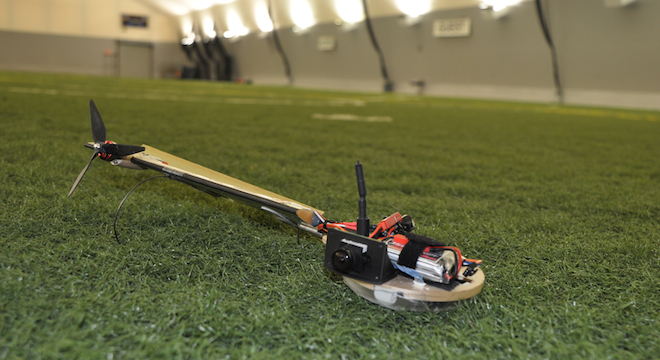Imagine a cheap, tiny, hovering aerial drone capable of being launched with the flick of a person’s wrist and able to provide manipulable 360-degree surveillance views.
It’s real, it’s inspired by maple seeds, and the company behind it, Lockheed Martin, envisions a future in which swarms of the new drones can be deployed at a fraction of the cost and with greater capabilities than drones being used today by the military and other agencies.
“Think about dropping a thousand of these out of an aircraft,” said Bill Borgia, head of Lockheed Martin’s Intelligent Robotics Lab, in a phone interview with TPM, “Think about the wide area over which one collect imagery. Instead of sending one or two expensive, highly valuable aircraft like we do today, you could send thousands of these inexpensive aircraft, and they are almost expendable.”
The new drone which looks like very similar to a maple seed, with a small pod-like body attached a single whirring blade, is called the Samarai. The name is derived from the Latin word “samara,” which means a winged seed, just like the one that inspired its physical design, flight pattern and construction.
In June, Lockheed Martin released a video demo of the drone’s capabilities, and it is clearly impressive, launched by hand and piloted using a tablet computer, which also displays the drone’s live surveillance feed.
“You can literally pull this out of your pocket, throw it into the air, and it can start flying,” Borgia told TPM. “It can take off and land vertically indoors.”
Borgia said that the drone, or unmanned aerial vehicle (UAV), was designed to be deployed in confined settings, such as urban environments or even inside buildings, where it could be piloted into different rooms and hover outside of windows, collecting surveillance footage with ease.
The technology behind the drone is even more sophisticated than it looks. There are only two moving mechanical parts in the entire tiny 30-cm aircraft: The piece that makes the propeller rotate and a flap on the large wing that comprises most of the drone’s form.
Then there’s the Samarai’s realtime video feed, which an operator can pan and tilt in a full 360 degrees, a capability not found on any other drone of its class, this despite the fact that the drone only contains one camera which is constantly being whipped around by the rotating motion of the aircraft itself.
In order to obtain a steady video feed with the ability to virtually pan and tilt, Lockheed relies on a series of image processing algorithms, Borgia told TPM.
“The algorithms sort of de-rotate the video and turn it back into a frame-by-frame view, similar to what you would see on any basic TV,” Borgia said. “All of the image processing is done onboard.”
That means that even if disconnected from the cloud or a control server, the Samarai would still be able to provide its operators with constant surveillance capabilities.
Borgia declined to specify the drone’s range or endurance, that is, the time it’s able to stay aloft in the air.
However, he did note that the Lockheed researchers behind Samarai had experimented with battery-powered and carbon-based fuel versions (the battery powered version is the one demonstrated in the video). Borgia further said that the researchers had “developed simulation tools that allow us to scale the vehicle to meet specific applications,” asked for by customers.
Lockheed Martin has not revealed any of its customers or potential partners on the Samarai yet, but Borgia said the company would make announcements “when the customers were ready.”
Besides the 30-cm version shown in the June demo video, Lockheed also has field-tested a 17-cm version and is working now to scale down the Samarai even further, to the size of an actual maple seed.
Asked about any potential privacy concerns presented by the Samarai, especially in light of the recent release of a voluntary industry “code of conduct” from drone manufacturers, Borgia said that “customers will have to work through the hurdles.”
Lockheed Martin began work on the Samarai in 2007 under a Defense Department program called “nano air,” designed to produce “an extremely small, ultra lightweight air vehicle system.”






